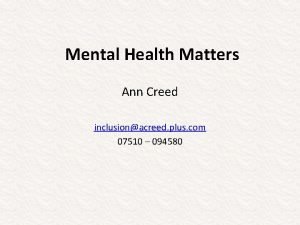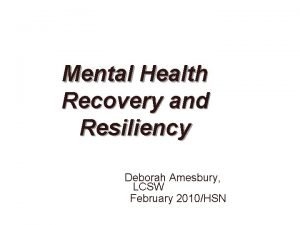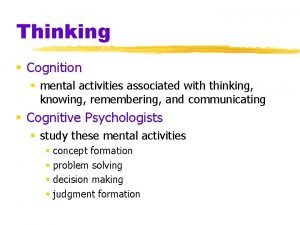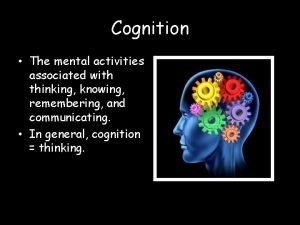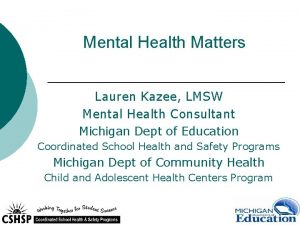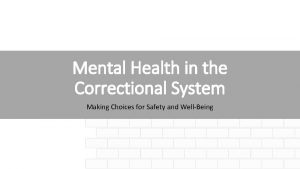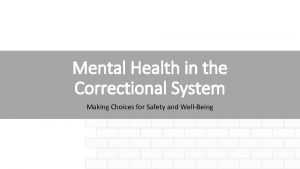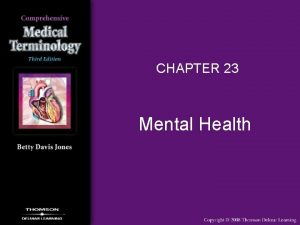MENTAL HEALTH MATTERS MENTAL HEALTH Making choices Thinking


































- Slides: 34

MENTAL HEALTH MATTERS

MENTAL HEALTH Making choices Thinking Feeling Our outlook Coping with life situations Self image Facing daily activities Behavior Relationships Handling stress

MENTAL HEALTH CONTINUUM Good mental health Mental health problems Serious mental illness

MENTAL HEALTH PROBLEMS Are short term reactions to a life stressor A relationship ending The death of someone close Conflict with family or friends Stresses at home, school, or work

Good mental health Mental health problems Serious mental illness Fill in the blank 1 in ___ 5 teens has some type of mental health problem in any given year.

MENTAL ILLNESS A medical condition Disrupts a person’s thinking, feeling, mood, ability to relate to others, behavior and daily functioning Interferes with a person’s ability to care for themselves, to get along with others, to go to school or work, and to learn

Good mental health Mental health problems Serious mental illness Fill in the blank 1 in ___ 17 Americans suffer from serious mental illness. Good news!! Recovery is possible. Most people can experience relief from symptoms…

MENTAL HEALTH CONTINUUM Good mental health Mental health problems Serious mental illness

WARNING SIGNS The longer the signs last… the more serious they are… the more they interfere with daily life… The greater chance that professional treatment is needed.

WARNING SIGNS finding little or no pleasure in life feeling worthless or extremely guilty crying a lot for no particular reason withdrawing from other people experiencing severe anxiety, panic, or fear

WARNING SIGNS having big mood swings experiencing a change in eating or sleeping patterns having very low energy losing interest in hobbies and pleasurable activities

WARNING SIGNS having too much energy, having trouble concentrating or following through on plans feeling easily irritated or angry experiencing racing thoughts or agitation

WARNING SIGNS hearing voices or seeing images that other people do not experience believing that others are plotting against you wanting to harm yourself or someone else

EARLY ONSET MENTAL ILLNESS Depression Bipolar disorder Attention deficit hyperactive disorder (ADHD) Oppositional defiant disorder/conduct disorder Anxiety disorders Eating disorders Schizophrenia

QUESTIONS FOR DISCUSSION What mental illness does this person have? How did the illness affect the person’s thoughts? How did the illness affect the person’s feelings? How did the illness affect the person’s behaviors?

What kinds of treatment did the individual get? How has the individual’s life changed after treatment? What is hopeful about this story? If this was one of your friends or a family member, what would you have done to help?

TAKING CARE OF YOUR MENTAL HEALTH a trusted adult to talk with a healthy balance between work, play, and relaxation good nutrition (food pyramid) plenty of sleep (8 ½ to 9 hrs per night) regular exercise learning how to control stress getting professional help if something is wrong

ATTITUDE SURVEY 1: People should work out their own mental health problems. When people have a physical health concern, they usually go to the doctor or seek other help. Mental health problems are associated with disturbances in the brain and can require professional help.

ATTITUDE SURVEY 2: Once you have a mental illness, you have it for life. Most mental illnesses are lifelong, but they often happen in episodes. People with mental illness can, when their illness is managed, live positive and productive lives.

ATTITUDE SURVEY 3: Medication is the only treatment for a mental illness. Medication can be a very effective part of managing a mental illness, but not the only one. Counseling, social, school/work, housing supports, peer support, and lifestyle changes are important in helping people recover and stay well.

ATTITUDE SURVEY 4: People with mental illness are violent and dangerous. Mental illness plays no part in the majority of crimes committed in our society. More often, people living with mental illness are the victims of violence.

ATTITUDE SURVEY 5: Children and adolescents cannot get a mental illness. Mental illnesses often strike during adolescence and young adulthood. Half of all lifetime cases of mental illness begin by age 14.

ATTITUDE SURVEY 6: You can tell by looking at someone whether they have a mental illness. Generally, you can’t tell if a person has a mental illness based on their appearance. During acute episodes of an illness, people may display bizarre behaviors.

ATTITUDE SURVEY 7: Mental illness can happen to anybody. It’s likely that you, or someone you’re close to will experience a mental illness. Persons of any age, race, religion, or income can be affected.

REMINDERS Mental health is as important as physical health. Mental illnesses are real and deserve to be treated. It's not a person's fault if he or she has a mental illness.

Mental health problems are not something you can “just snap out of ” even if you try. It's OK to ask for help and get it. There is hope. People improve and recover with the help of treatment, and they are able to enjoy happier and healthier lives.

WHAT CAN I DO TO HELP? Be a good friend to those who struggle with mental illness. Take care of your own mental health. Communicate with adults any concerns you have. Help change attitudes around you.

CHANGING ATTITUDES Learn more about mental illness Listen to people who have experienced mental illness Watch your language – for terms that perpetuate stigma Respond to stigmatizing material in the media

CHANGING ATTITUDES Speak up about stigma Talk openly about mental illness Demand change from your elected representatives Provide support for organizations that fight stigma

ADDITIONAL RESOURCES

TYPICAL TEEN BEHAVIOR Typical teenagers may: Be moody at times Be short tempered-especially when parents are setting limits. See family activities as less important and view friends as the focus of their life. Seem embarrassed to be with their parents or siblings. Use angry responses to get some distance from parents. Be distraught when they are having relationship difficulties.

TYPICAL TEENAGERS SHOULD Enjoy a number of activities. Have fun when they are with friends-smiling and laughing. Have good relationships with other adults, teachers, coaches, etc. Enjoy occasionally a few activities with parents/siblings. Talk with their parents about feelings intermittently. Be able to function in school. Ask yourself- what percentage of time are you happy? Or, what are you enjoying about your life? If you are not happy most of the time or if joy is missing from your life, it is time to talk to a trusted adult. There is help out there!

CAUSES OF MENTAL ILLNESS Genetics Environment Social influences All of these factors interact to increase or decrease a person’s risk for developing mental illness.

A COMPARISON DIABETES MENTAL ILLNESS Pancreas Brain Pancreas produces little or no insulin affecting person’s blood levels. Brain produces too much or not enough of neurotransmitters. There is no cure yet but people can manage their illnesses through medication treatment, lifestyle changes, etc. There is no cure yet but a person can usually be treated effectively to reduce the symptoms and allow the person to function in work, school or socially. 18. 2 million people When applied to 2004 Census estimate for 18 or older 57. 7 million people. In the United States-6. 3 percent of the population-have diabetes, a serious, lifelong condition. An estimated 26. 2 percent of Americans ages 18 and older — about one in four adults — suffer from a diagnosable mental disorder in a given year.
 When making smart food choices what question
When making smart food choices what question Is evaluating alternatives and making choices among them.
Is evaluating alternatives and making choices among them. Evaluating alternatives and making choices among them
Evaluating alternatives and making choices among them Chapter 8 thinking language and intelligence
Chapter 8 thinking language and intelligence A guide for making healthful daily food choices
A guide for making healthful daily food choices Making proud choices curriculum
Making proud choices curriculum Lesson 3: guidelines for eating
Lesson 3: guidelines for eating Lesson 3 guidelines for eating
Lesson 3 guidelines for eating Chapter 1 section 3 economic choices and decision making
Chapter 1 section 3 economic choices and decision making Chapter 20 mental health and mental illness
Chapter 20 mental health and mental illness Stress management jeopardy
Stress management jeopardy Health matters paragraph
Health matters paragraph Health matters amesbury
Health matters amesbury Positive thinking vs negative thinking examples
Positive thinking vs negative thinking examples Thinking about your own thinking
Thinking about your own thinking Dichotomistic
Dichotomistic Perbedaan critical thinking dan creative thinking
Perbedaan critical thinking dan creative thinking Thinking about you thinking about me
Thinking about you thinking about me Community health choices waiver
Community health choices waiver Better choices better health sd
Better choices better health sd Earmarks of nutrition quackery
Earmarks of nutrition quackery Critical thinking poster making
Critical thinking poster making Critical thinking problem solving and decision making
Critical thinking problem solving and decision making Making inferences
Making inferences War making and state making as organized crime summary
War making and state making as organized crime summary All the mental activities associated with thinking
All the mental activities associated with thinking The mental activities associated with thinking
The mental activities associated with thinking Stadium staffing simulation
Stadium staffing simulation Inner well being
Inner well being Say, mean matter sentence starters
Say, mean matter sentence starters Race matters for juvenile justice
Race matters for juvenile justice Nothing matters question tag
Nothing matters question tag Why punctuation matters
Why punctuation matters Why productivity matters
Why productivity matters Nationwide care matters 2
Nationwide care matters 2











